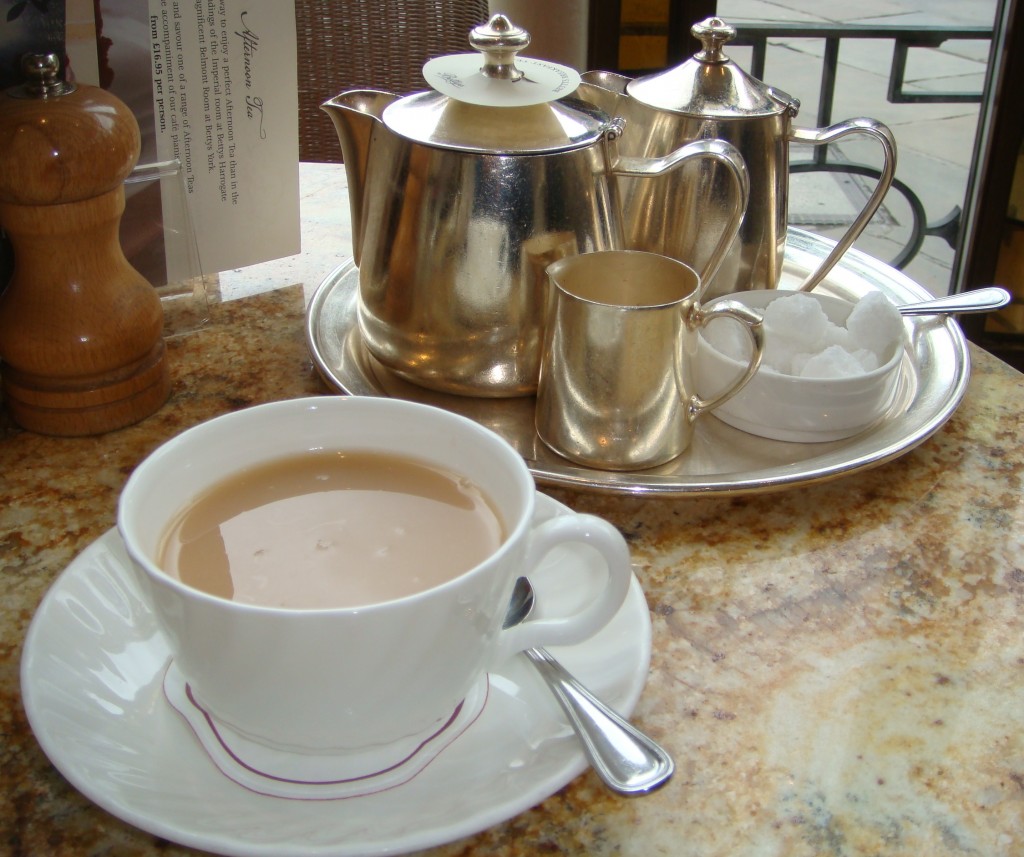In the 11th century, the tradition started of Benedictine monks eating bread with cream and jam at Tavistock Abbey in Devonshire. A proper Devon cream tea has a scone split in half with clotted cream and jam spread on both halves.

One of my guidebook smirks that older “blue-rinse ladies” are the ones most interested in cream teas. The cream tea set of the London blitz, and then those of my baby-boomer era, might take the market for scones and clotted cream along with us when we all die. But, before we go, we’ll remind the world of British colonial might with every afternoon repast. Teas and sugars were only grown in British colonies, and Crusaders first introduced exotic dried fruits, which are now found in so many British baked goods. Tea and scones bring martial, imperial, and glory days of Britain to even the most modest of daily tables.
Modern Britain, on the other hand, has been challenged by white working-class subcultures throughout its history, from teddy boys to rockers to punks and now (as of 2011 anyway) chavs. “Innit” is a chav abbreviated mashup for “is it not?” and is attached liberally to statements, questions, and phrases, such as “Terrible weather, innit?” but then also “You’re going out to look for a job today, innit?”
Chavs often wear knockoffs of Burberry, Reebok, and Nike, an example of “proletarian drift,” where one group’s products and styles are consumed by a lower socio-economic group. Yet, the tearoom ceremony of an older, traditional cultural oasis of Britishness, holds steady in a wildly pitching sea of globalization, working-class subcultures, kebab takeaways, and calls to eat healthier. And no one does trad quite like Bettys.
York is dismally wet and spitting on this late afternoon as I push the door open into Bettys Tearooms. My bus tour of the United Kingdom and Ireland with a college group had been building up to this moment. Gently ushered to a table, I slide my pack underneath the table and arrange my raincoat on the chair. I realize with a start that I am at the best table, centered at the dining room’s vortex overlooking St. Helen’s Square in York’s old medieval section. Locals and tourists are strolling outside, sitting on benches, talking on cells, posing for photos, checking maps.
As I arrange my muffler, journal, and pens, two cheerful young ladies arrive at my elbow, trainer and trainee, perhaps. I order the salmon salad and Bettys’ famous Yorkshire Fat Rascal. Showing mild alarm, the trainer suggests I get the salad but then get my Rascal as a takeaway. Should I now reveal my plastic containers poised to receive half portions of each? Or disclose that I’m writing about tea and scones as a social oasis within British culture? I insist on both items together with a pot of strong tea. I examine my surroundings. The art deco artwork is exquisite.
An orphaned Swiss immigrant, Fritz Butzer, had arrived in Yorkshire in 1907. His father had been a miller and master baker, and Fritz had had extra training in baking and chocolate confectionery in Europe before heading for London and, taking the wrong train, thus arrived in York. He changed his name to Frederick Belmont, married an English woman, and looked for opportunities to start his own bakery. The “betty” name comes from an early cartoon design of “Lady Betty” on the company’s chocolate. Originally a Gibson Girl beauty, Lady Betty morphed into a redheaded Betty Boopish figure selling chocolates from a tray.
Between the wars, Frederick and Claire Belmont took a cruise on the Queen Mary and admired the ship’s art and design. Bringing the designer to his tearoom, Belmont insisted on the same style for his stained-glass windows, whose leaves, branches, and flowers I now admired in an atmosphere of calm and status.
Calm and status? Featuring a whimsical name such as the Fat Rascal? This large, saucer-sized scone has a long history, originating in Elizabethan times. Inspired by the traditional Rock Cake or Rock Bun, it is also sometimes called a Turf Cake and was first baked in York. You can even order four Fat Rascals for £15 from Bettys by Post, packed in a box and tied with a red ribbon. Fat Rascal Club members partake of scone varieties together, such as the Breakfast Rascal with bacon, eggs, sausage, and beans: a full English fry-up on a scone.
Has Britain started on its own trajectory of scone devolution? Is a York Sconecutter franchise far behind? But worries of franchises and the assaults of the weather melt away as I frost my Rascal with buttermilk-yellow clotted cream from a ramekin: such elegance and daintiness for a woman in hiking boots and online Lands’ End clothing in this quiet chapel of Britishness.
Walking out of Bettys that evening under a cream-colored sky, there is calm and order in the female breast. As if someone had lowered a great padded cosy over me, offering warmth and protection from all assaults. The streets and alleyways dim with broody twilight, clerks turn Closed signs to the street, and St. Helen’s Square cobbles glisten like trout scales. Wandering through this poetic weather toward my hotel, I reknot my scarf and zip up my rain jacket. There will be more scones and tea tomorrow.
The clouting of cream goes back to Devon’s Tavistock Abbey estates in the early 1300s. Because they didn’t use churns to make butter, monks scalded their milk. The resulting clotted cream was stirred and then made into butter.
During the sixteenth and seventeenth centuries in Cornwall, clotted cream and butter became the best ways to preserve milk. Later, in British dairies, farmers’ wives would set out a bowl of cream to “settle” for several hours. They would then scald it and let it simmer overnight on their kitchen ranges. As it cooled the next day, the thick, yellow cream was skimmed off and layered into a bowl. Countries other than England also enjoy clotted cream. In Serbia it’s called kajmak; in Turkey it’s kaymak, and in India it’s malai.
A lot of cream will only make a small amount of clotted cream: one pint of cream makes a little less than half a cup. To make your own:
Pour 2 pints heavy cream into a baking dish, leave it overnight in the oven at 180 degrees.
In the morning, take dish out and let cool, refrigerate rest of the day.
Scoop into jars or ramekins and put back in refrigerator, it’s ready the next morning.
Fat Rascals
INGREDIENTS
2 cups flour and ½ cup flour
2 teaspoons baking powder and ½ teaspoon baking powder
½ cup cold butter, cubed and 1 Tablespoon cold butter, cubed
½ cup fine white sugar
Zest of 1 orange and the zest of 1 lemon
1 teaspoon ground cinnamon
2/3 cup raisins, and 1/3 cup sultanas
2 large eggs
4 tablespoons heavy cream
8 glacé cherries and 24 blanched almonds
DIRECTIONS
Preheat oven to 400 degrees
Mix flour and baking powder in large bowl, add butter and rub till crumbly
Stir in sugar, zests, cinnamon, raisins and sultanas
Stir in one egg plus 3 tablespoons cream
Mix by hand, adding more cream if necessary
Flatten out dough to 3/4” thick
Cut about eight 3”-wide (size of a standard hockey puck) rounds, place on cookie sheet
Whisk remaining egg and brush on tops of rounds
Make faces with almonds and cherry slices and bake for 15 to 20 minutes till golden brown.
Best eaten the same day but can be frozen up to a month.
There are five Bettys Tearooms altogether in the UK.

Post a Comment